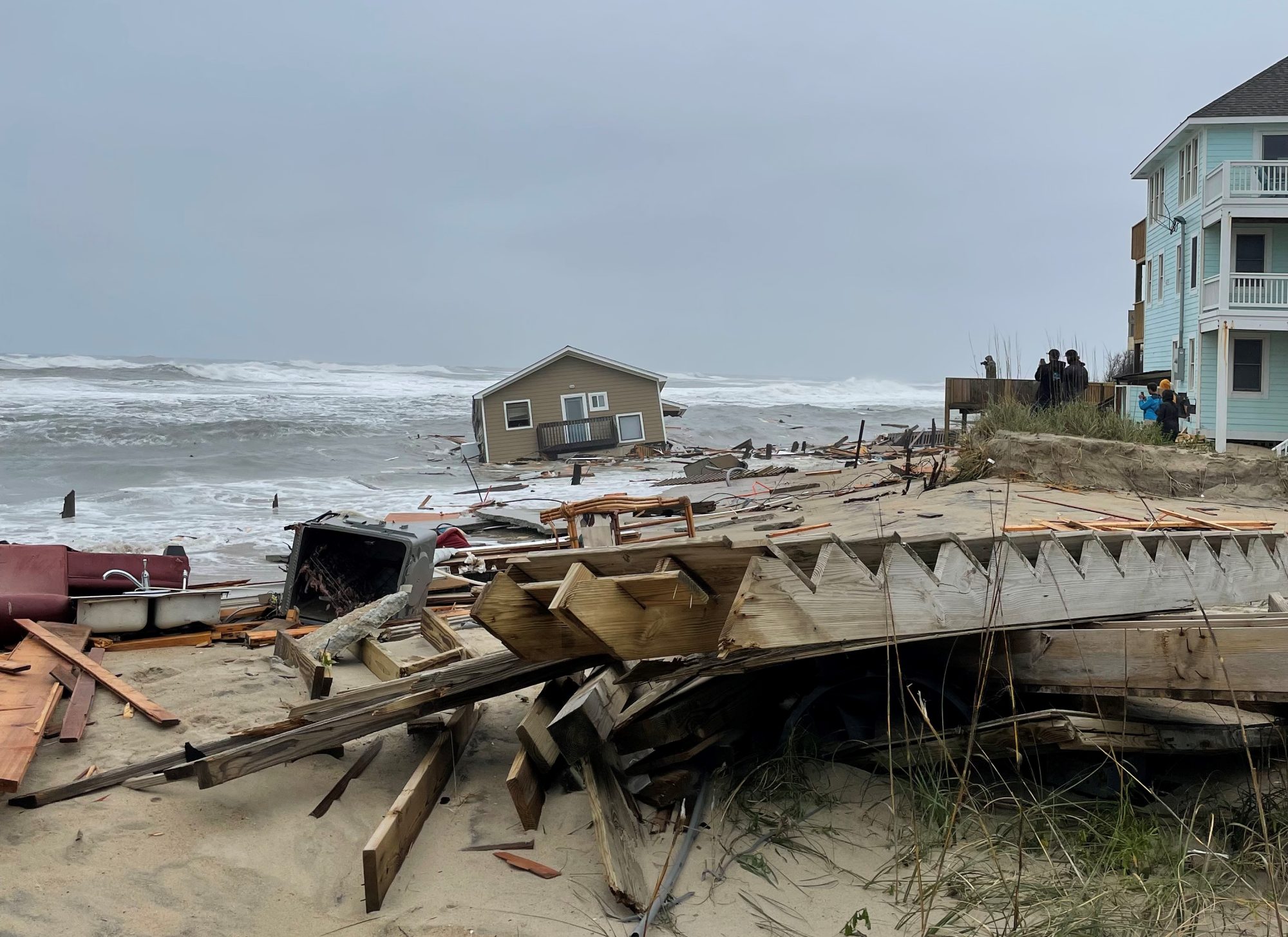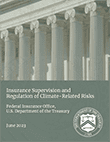
Even with the might of government, it can be difficult to force people to remove their houses that are at risk of falling into the ocean.
More and more, it’s also proving to be difficult for homeowners to find property insurance that would adequately cover, or proactively prevent, that risk.
Supporter Spotlight

But a Federal Insurance Office report, “Insurance Supervision and Regulation of Climate-Related Risks,” released in June shows that the insurance industry is lagging in addressing the wide range of escalating climate hazards far beyond covering oceanfront coastal development.
“More work is needed by state and federal regulators and policymakers, as well as by the private sector and the climate science and research communities,” the report said, “to better understand the nature of climate-related risks for the insurance industry, their implications for insurance regulation and supervision, and for the stability of the financial system — including for real estate markets and the banking sector.”
With alarming spikes in recent years in flood, storm and wildfire disasters, and with property insurers fleeing Louisiana, Florida and California, homeowners are increasingly paying more for less insurance, having policies canceled with no warning, or searching in vain for coverage.
“I think we’re definitely at an inflection point where insurers are pricing themselves out of doing what they’ve been counted on to do for generations,” said Amy Bach, executive director of United Policyholders, a San Francisco-based nonprofit information resource for insurance consumers in all 50 states and the District of Columbia. “This is clearly a national matter.”
One dramatic climate risk, in the form of severe beach erosion, has been on full display in Rodanthe, an Outer Banks village on the northern end of Hatteras Island where, since 2020, five oceanfront houses have collapsed into the Atlantic, scattering debris for miles in the water and on beaches along Cape Hatteras National Seashore.
Supporter Spotlight
Related: Federation, law center call for enforcement of existing law
Government-subsidized flood insurance policies won’t pay policyholders until the house is destroyed, nor will they cover proactive removal or cleanup costs for debris.
Although property owners in Rodanthe want Dare County to pay for a beach nourishment project, which could protect houses and restore flood insurance coverage, the county has said that the high rate of erosion — an annual average of about 14 feet — and the relatively small number of affected properties would make it prohibitively expensive.
A recently released engineering report completed for the county estimated that for a project covering 5.7 miles of beach, it would take about 3.8 million cubic yards of sand to offset five years’ worth of erosion, with a one-time cost of about $40 million.
Dare County Board Chairman Bob Woodard said during the commission’s June 5 meeting that U.S. Rep. Greg Murphy, R-N.C., indicated that it may be possible to secure federal nourishment funds.
“There are some folks in Rodanthe that appear to have some pretty strong ties to representatives in D.C. that are trying to help (the congressman) make this happen,” Woodward said. Commissioners agreed to send a letter to Murphy requesting $40 million for the nourishment project.
In a June 16 response to Woodard, Murphy wrote that a feasibility study would have to be performed by the U.S. Army Corps of Engineers that was estimated to cost “a minimum” of $3 million, before a funding request could be made.
A spokesman for Murphy, responding to an inquiry from Coastal Review in a June 26 email, said that the congressman and his team had been in touch with commissioners prior to their request, and he is continuing to discuss “a plan of action and the best way ahead” as the situation evolves.
“Congressman Murphy has been closely monitoring the conditions in Rodanthe and has witnessed the erosion firsthand,” the spokesman wrote.
Starting in the late 1980s, there had been a provision in the National Flood Insurance Program known as the Upton-Jones Act that had provided funds to demolish or relocate houses threatened by encroaching surf on an eroding beach. It lasted less than eight years.
Revival of Upton-Jones or a similar measure is currently being reconsidered by government officials and policymakers as one remedy for the Rodanthe problem. The Upton-Jones Amendment had funded up to 40% of the policy to move houses and up to 110% to demolish them. The maximum payout was $185,000 for the structure and $60,000 for its contents.
But as federal and state laws so far appear toothless to thwart houses from falling onto public beaches, escalating threats created by rising seas, intensifying rainfall and raging wildfires are exposing looming deficiencies not just in the National Flood Insurance Program, but in property insurance overall.
Climate-related risks categorized broadly as physical, transition and litigation, the report found, “present new and increasingly significant challenges for the insurance industry that warrant careful monitoring by financial regulators, policymakers, and insurance companies. The oversight of climate-related risks is also an emerging and increasingly critical topic for state insurance regulators.”
Potential revival of the Upton-Jones Act, which was repealed by Congress in 1994, was part of a broader discussion on insurance options for properties on the vulnerable Atlantic shoreline during the second virtual video meeting of the Threatened Oceanfront Structures Interagency Work Group.
Established jointly in August 2022 by the National Park Service and the North Carolina Division of Coastal Management to seek solutions for the problem in Rodanthe, the group appeared to view the flood program as a concern most relevant to the bottom line.
“And that is the question of the house is going to collapse,” Cape Hatteras National Seashore Superintendent Dave Hallac said to the online group, which included about 24 panelists and 25 attendees. “There’s not only going to be the cost of the payout … but now there is also going to be environmental damage potentially and the cost of cleanup. It is hard to image that that is going to be more than an orderly move.”
During two hours of discussion, the panel agreed that there are gaps in qualifications meeting the need for available grants, and government codes and regulations need to be updated, as well as information on erosion rates. Considering the lack of available private insurance coverage, the recently updated NFIP Risk Rating 2.0 seems to provide the best option for flood coverage. But there were questions whether a new Upton-Jones program would be more appropriate as a hazard mitigation program, rather than insurance.
Even with the updated program that is gradually increasing rates, flood insurance premiums are 50% below what they need to be, said Spencer Rogers, a retired North Carolina Sea Grant coastal engineer and geologist.
“And that’s a major issue for the program,” he said, “that any analysis that’s going to … cost additional money for the flood insurance program needs to address the money.”
As Bach, with the consumer insurance group, explained, recent rate increases have been influenced by inflation and supply-chain issues, but a primary driver is reinsurance, essentially transferring risk to another insurer to protect the primary insurer. But the newest drivers, she said, are insurance technology rating tools that provide much more detail on the risks.
With those analytic tools, California and other states have realized that calculating risks with models that are predicting the future based on the past has greatly underestimated the actual risks.
Bach said the situation currently is reminiscent to what happened in the 1960s, when property insurance for flooding became essentially unaffordable and unavailable, resulting in the federal government creating the subsidized National Flood Insurance Program, or NFIP. For a large number of homeowners, options today for property insurance could mean going into more debt by financing the insurance; paying higher rates year over year; having bare minimum insurance; or having no insurance. Insurers, she said, are “running away from catastrophic risk at the same time that they have been raising their rates.”
All Federal Deposit Insurance Corp.-backed mortgages require homeowners insurance, but even uninsured property owners without mortgages often need federal assistance after disasters.
“I think there are increasingly loud cries for there to be a version of the NFIP, basically an American disaster insurance program … in the sense that it’s an insurer of last resort for people who can’t get coverage elsewhere,” Bach said. “But I think that’s what we’re going to be seeing more (demand) for because insurers are a powerful lobby, but so our Realtors and so our builders and so our voters. So at some point a solution is going to have to be found here, but it’s increasingly looking like it’s not going to be the private property insurance system as we’ve known it.”
Bach said that the questions going forward are, what insurance program are elected officials going to come up, and what will the recipe look like? As Bach sees it, people are going to continue to want to live near beautiful coasts and forests, or stay where their family has been rooted for generations for as long as possible.
“They didn’t come to the risk,” she said. “The risk came to them while they were there.”







